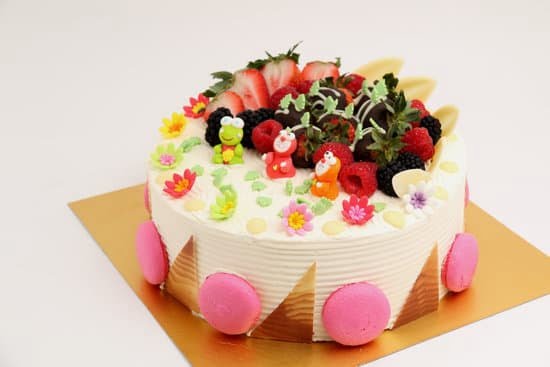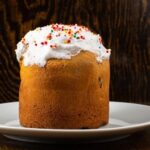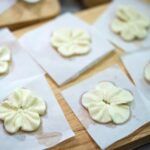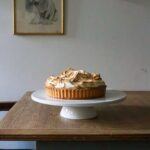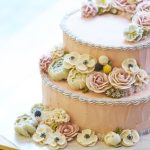How do you make edible cake decorations? Creating beautiful and delicious decorations for your cakes is an art form that can take your baking to the next level. From fondant to royal icing, there are a variety of techniques and materials you can use to bring your cakes to life with edible designs. In this article, we will explore the world of edible cake decorations, from choosing the right ingredients to mastering different decorating techniques.
When it comes to making edible cake decorations, using the right ingredients is crucial for both taste and safety. We will discuss how to choose high-quality ingredients that are safe for consumption and provide tips for ensuring that your decorations not only look stunning but also taste delicious.
In addition, we will explore the essential tools and equipment needed for creating edible cake decorations. Whether you’re working with fondant, royal icing, gum paste, or edible printables, having the right tools at your disposal can make all the difference in achieving professional-looking results. So let’s delve into the fascinating world of edible cake decorations and discover how you can elevate your baking skills with these creative techniques.
Choosing the Right Ingredients
When it comes to making edible cake decorations, choosing the right ingredients is crucial not only for the aesthetic appeal of your creations but also for food safety. Using high-quality, edible ingredients will ensure that your decorations not only look great but are also safe for consumption.
One of the key considerations when choosing ingredients for edible cake decorations is their shelf life and stability. For example, using fresh fruit as a decoration may look beautiful initially, but it can quickly wilt and spoil, posing a food safety risk. Opting for dried or dehydrated fruits can provide a longer-lasting and safer alternative.
In addition to considering the longevity of your ingredients, it’s important to take into account any dietary restrictions or allergies that you or your guests may have. Using gluten-free flours, dairy-free chocolate, or vegan-friendly coloring agents can ensure that all your creations are inclusive and safe for everyone to enjoy.
How Do You Make Edible Cake Decorations?
| Ingredient Considerations | Details |
|---|---|
| Shelf Life and Stability | Opt for ingredients with a longer shelf life to ensure longevity of decorations |
| Dietary Restrictions and Allergies | Use allergen-free alternatives to accommodate various dietary needs |
Tools of the Trade
When it comes to creating edible cake decorations, having the right tools is essential for success. Whether you’re working with fondant, royal icing, gum paste, or edible printables, having the proper equipment can make the process much easier and more enjoyable. In this section, we’ll explore the essential tools of the trade that every aspiring cake decorator should have in their arsenal.
One of the most basic yet crucial tools for making edible cake decorations is a set of quality decorating tips and piping bags. These will allow you to create intricate designs and fine details with royal icing or buttercream.
Additionally, a collection of different shaped cutters and molds can be incredibly useful when working with fondant or gum paste. From flowers and leaves to letters and numbers, having a variety of molds and cutters on hand will give you plenty of options for creating unique decorations.
Another essential tool for any cake decorator is a rolling pin specifically designed for use with fondant or gum paste. This will help you roll out your medium of choice to an even thickness, ensuring that your decorations look polished and professional.
Additionally, a fondant smoother can be used to eliminate any wrinkles or air bubbles when covering a cake with fondant, resulting in a smooth and flawless finish. These are just a few examples of the many tools available to cake decorators, each serving its own unique purpose in the creation of stunning edible cake decorations.
In addition to these basic tools, there are countless other gadgets and accessories that can make the process of creating edible cake decorations easier and more efficient. From shaping wires and floral tape to edible food coloring pens and airbrush kits, there’s no shortage of specialized equipment available for those looking to take their cake decorating skills to the next level.
By investing in high-quality tools and equipment, you can ensure that your homemade edible cake decorations will be both visually impressive and safe for consumption.
Fondant Finesse
Fondant is a popular choice for creating edible cake decorations due to its versatility and smooth, pliable texture. Whether you’re a beginner or an experienced baker, mastering the art of working with fondant can take your cake decorating skills to the next level. So, how do you make edible cake decorations with fondant?
To begin, you’ll need a few key ingredients: marshmallows, confectioners’ sugar, water, and gel food coloring. Start by melting the marshmallows in the microwave and gradually adding sifted confectioners’ sugar until it forms a dough-like consistency. Knead the fondant on a clean surface dusted with confectioners’ sugar until it becomes smooth and elastic. To add color, simply knead in gel food coloring until you achieve your desired shade.
Once you’ve made your fondant, it’s time to start working with it. Roll out the fondant on a surface dusted with confectioners’ sugar to prevent sticking. Use a rolling pin to achieve an even thickness, and drape the fondant over your cake to cover it completely.
Smooth out any air bubbles or wrinkles using a fondant smoother or your hands. With practice and patience, you can create flawless finishes and intricate designs using fondant for your edible cake decorations.
Mastering Royal Icing
Royal icing is a versatile and delicious way to add intricate and beautiful designs to your homemade cakes. Made from powdered sugar, egg whites, and flavoring, royal icing can be used to create delicate lace patterns, intricate flowers, and detailed piping on cakes of all shapes and sizes. But how do you make edible cake decorations with royal icing? Here are some tips and tricks to help you master the art of royal icing for your next baking project.
First and foremost, it’s essential to have the right consistency when working with royal icing. Depending on the design you want to create, you may need different consistencies of royal icing. For fine details and writing, a thicker consistency is necessary, while for flooding or covering larger areas, a thinner consistency is needed. Achieving the perfect consistency takes practice and patience, so don’t be discouraged if it doesn’t come out perfectly on your first try.
Another important tip for working with royal icing is to ensure that your tools are clean and free from any grease or residue. Even the slightest bit of oil can ruin the texture of royal icing, causing it not to set properly or creating an uneven finish. Before using any piping bags, tips, or other equipment with royal icing, make sure they are thoroughly cleaned and dried to avoid any issues during decoration.
When creating intricate designs with royal icing, it’s also crucial to plan ahead and practice your technique before applying it directly onto your cake or cookies. Practicing on parchment paper or wax paper will give you a chance to perfect your piping skills and test out different designs before committing them to your final baked goods.
| Royal Icing Tip | Details |
|---|---|
| Consistency is Key | Achieving the right consistency for different designs takes practice |
| Clean Tools | Ensure that all tools are clean and free from grease before using them with royal icing |
| Practice Makes Perfect | Practice piping techniques on paper before applying them to baked goods |
Sculpting With Gum Paste
Understanding Gum Paste
Gum paste is a versatile and pliable sugar-based dough that is perfect for creating intricate and detailed decorations for your cakes. It can be molded, sculpted, and shaped into a wide variety of designs, making it ideal for crafting 3D elements that will take your cake to the next level. Gum paste is also known for its quick-drying properties, which means that your creations will hold their shape once they are set in place.
Creating 3D Decorations
To create 3D decorations with gum paste, start by kneading the gum paste to make it more pliable. Roll it out to your desired thickness and use various shaping tools to sculpt the gum paste into shapes such as flowers, leaves, figurines, or other intricate designs. You can also use molds to create uniform shapes and textures for your decorations.
Tips for Success
When working with gum paste, it’s important to keep your work surface clean and dusted with powdered sugar or cornstarch to prevent sticking. Use small amounts of water or edible glue to help pieces adhere together seamlessly. Additionally, allow your gum paste decorations to dry fully before placing them on your cake. This will ensure that they maintain their shape and structure throughout the display.
By mastering the art of sculpting with gum paste, you can add stunning 3D decorations to your cakes that will impress any guest or client. With practice and patience, you can create show-stopping designs that showcase your creativity and skill in edible cake decoration.
Painting and Coloring Techniques
Using Food Coloring
When it comes to painting and coloring techniques for edible cake decorations, food coloring is a must-have tool. Gel or paste food coloring works best as it provides vibrant and concentrated colors without adding too much moisture to your fondant or gum paste. To create different shades and hues, mix different colors together on a clean, dry palette using a paintbrush.
Airbrushing Techniques
For a professional finish, consider investing in an airbrush kit specifically designed for use with edible colors. Airbrushing allows for smooth, even coverage and the ability to create intricate gradients and shading effects on your edible decorations. Practice on a spare piece of fondant or gum paste first to get the hang of controlling the airbrush before moving onto your actual decorations.
Adding Details With Food-Safe Paints
In addition to traditional food coloring and airbrushing, you can also use food-safe paints to add fine details and embellishments to your edible cake decorations. These paints are specially formulated for use on edible surfaces and come in a wide range of colors, including metallics and shimmer finishes. Use a small, fine-tipped brush for precision when applying details such as delicate flowers or intricate patterns.
By mastering these painting and coloring techniques, you can elevate your edible cake decorations from simple shapes and designs to true works of art. Experiment with different methods and practice regularly to hone your skills in adding depth and detail to your creations.
Edible Printables
To make edible cake decorations using edible printables, you will need the following supplies:
- Edible image printer: This specialized printer is designed to work with edible ink cartridges and edible paper sheets.
- Edible ink cartridges: These cartridges are filled with food-grade ink that is safe to consume.
- Edible paper sheets: Wafer paper or frosting sheets can be used as a canvas for your edible designs.
- Design software: To create custom images and designs, you will need access to design software that is compatible with your edible image printer.
Once you have gathered all the necessary supplies, you can follow these steps to make your own edible cake decorations:
- Design your artwork: Use design software to create or customize your desired images and text.
- Print the images: Load the edible ink cartridges into the printer and carefully align the edible paper sheets before printing your designs.
- Cut out the decorations: Once printed, carefully cut out the edible decorations using scissors or a craft knife.
With these easy steps, you can create personalized and detailed decorations for your cakes using edible printables. Whether it’s a birthday message, a company logo, or a themed design for a special occasion, edible printables allow you to bring any vision to life on your confections.
Putting It All Together
Assembling and arranging your edible cake decorations is the final step in creating a visually stunning and delicious masterpiece. Whether you’re working with fondant, royal icing, gum paste, or edible printables, the way you arrange and display your decorations can truly set your cake apart. Here are some tips for putting it all together:
- Consider the theme: Before you start arranging your decorations, think about the theme of the cake. Whether it’s a birthday, wedding, or any other special occasion, the theme should guide the placement of your edible decorations.
- Balance is key: When arranging your edible decorations on the cake, it’s important to achieve a sense of balance. Distribute different types of decorations evenly around the cake to create a harmonious overall look.
- Layering and depth: To add visual interest to your cake, consider incorporating different levels and dimensions with your edible decorations. Use a combination of flat and three-dimensional elements to create depth and texture.
By following these tips for assembling and arranging your edible cake decorations, you can elevate the overall presentation of your creation and impress everyone with both taste and aesthetics.
Remember that practice makes perfect when it comes to decorating cakes. Experiment with different techniques and styles to find what works best for you. And most importantly, have fun showcasing your creativity through homemade edible cake decorations.
Conclusion
In conclusion, learning how to make edible cake decorations allows you to showcase your creativity and personalize your baked creations. By choosing the right ingredients, using essential tools, and mastering various techniques such as fondant finesse, royal icing, gum paste sculpting, painting, coloring, and edible printables, you can elevate your cake decorating skills to new heights. The possibilities are endless when it comes to creating custom decorations that reflect your unique style and vision.
Making edible cake decorations not only adds a special touch to your baked goods but also ensures that they are safe for consumption. By using high-quality ingredients and following proper food safety practices, you can create stunning decorations that are not only visually appealing but also delicious. Your friends and family will be amazed by the professional-looking results of your homemade edible cake decorations.
In essence, the art of making edible cake decorations is a rewarding endeavor that allows you to express yourself through beautiful and tasty creations. Whether you’re a beginner or an experienced baker, mastering the various techniques involved in creating edible decorations will enable you to take your cakes to the next level. With practice and creativity, you can truly transform any cake into a work of art that reflects your individuality and passion for baking.
Frequently Asked Questions
How to Make Edible Cake Decorations at Home?
Making edible cake decorations at home can be a fun and creative process. You will need to start with a base of fondant or gum paste, which can be shaped and molded into various designs. This allows for endless possibilities, from simple flowers to intricate designs.
What Do You Need to Make Edible Cake Toppers?
To make edible cake toppers, you will need a few basic tools and ingredients. These include fondant or gum paste, food coloring gels for tinting the icing, various shaping tools like cutters and molds, and some imagination. The key is to have a steady hand and attention to detail when crafting your decorations.
What Are Edible Cake Decorations Made Of?
Edible cake decorations are typically made from fondant or gum paste, both of which are pliable and easy to mold into different shapes and designs. These ingredients are often mixed with food coloring gels to achieve the desired colors.
Traditionally, royal icing is also used for more delicate piping work on cakes as it dries hard and is ideal for creating intricate details such as lace designs or delicate flowers. This allows for a wide range of decorative options when it comes to edible cake decorations.

Welcome to our cake decorating blog! My name is Destiny Flores, and I am the proud owner of a cake decorating business named Cake Karma. Our mission is to provide delicious, beautiful cakes for all occasions. We specialize in creating custom cakes that are tailored specifically to each customer’s individual needs and tastes.

